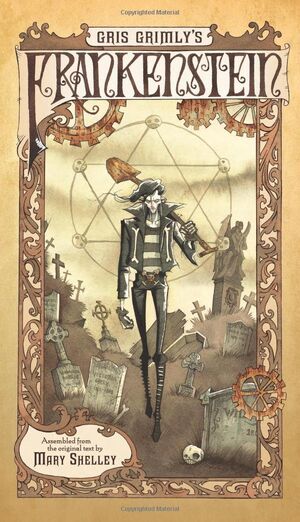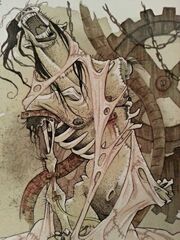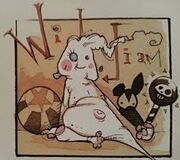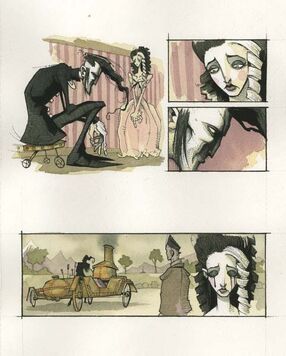Gris Grimly's Frankenstein is a graphic novel published in 2013 by Gris Grimly as an adaptation of Mary Shelley's Frankenstein. The front cover claims it was "Assembled from the original text by Mary Shelley," as it matches quotes from Shelley's novel with comic illustrations of every event in the novel. Grimly professes in the Afterword that he is following a long line of artists, his favorite being Bernie Wrightson, in illustrating "this monster", his "favorite horror story" (195).

Cover
Synopsis[]
The graphic novel formally retells Mary Shelley's narrative in its three volumes. Robert Walton's handwritten letters are illustrated first to set up the story as a frame narrative. These letters bookend the central narrative of Victor Frankenstein, who is brought aboard Walton's frozen expedition near the North Pole. During the relation of Victor's narrative from Volume I, Chapter I through Volume III, Chapter VII, Grimly's illustrations permit us to see that Victor has scientifically engineered a monster with superhuman strength and intelligence; that the monster has killed Victor's family and friends; and that Victor is on a mission of vengeance to destroy the monster. Victor dies on Walton's ship before he can exact his vengeance, and the monster arrives to express grief over having driven his creator to insanity and death. The graphic novel ends with a three-paned illustration of the monster fading away into the distance with Victor's body. This is a departure from the original novel, in which the monster leaves the body of Frankenstein behind.
Thematic Imagery[]
Technology and Anachronism[]

The monster emerging from its embryo
Rusted gears, tools, and vehicles figure prominently in many of Grimly's illustrations. For instance, the first few panels show Victor's father, a military general, riding on the back of a machine shaped like a horse. Victor even drives a car and is later seen biologically engineering the monster. This industrial and biological technology appears out of sync with a story that was set in the 18th century. However, much of it has to do with Grimly's steampunk style.
Victor's way of biologically engineering the monster with a green chemical solution and growing it inside of an embryo is especially anachronistic given that biotechnology of this kind would not have been available in the 18th century. It is likely that Grimly is following a trend in late-20th and early 21st century adaptations of Frankenstein, which often show the monster being born instead of being electrocuted into existence. Indeed, Grimly reverses the life-giving effect of electricity, showing it instead shocking the character Justine to death in an electric chair (70). Kenneth Branagh's 1994 film, Mary Shelley's Frankenstein combines electrcal and a biotechnological approaches to monster creation, showing amniotic fluid as the solution that Victor uses to electrocute an embroyonic sac that gives birth to the monster. Removed adaptations and appropriations of Frankenstein, such as 2009 Canadian horror film Splice, appear to venture further in this direction, showing monsters that are referred to directly as products of biotechnology.
While Grimly's text never refers to the monster as a product of biotechnology, he has written in his blog on the graphic novel about the importance of giving life to the work in the same way Victor gives life to the monster, i.e. in terms of "a diabolical Bio-physics ." His illustrations also suggest that Victor is working with more than just mechanical technology or alchemy; for there is an implied biochemistry in Victor's concotion of the green fluid that gives life to his monster, as well as an implied biophysics in his construction of the artificial embryo from which it is born.
Rural vs. Urban[]
Illustrations of natural landscapes contrast sharply with illustrations of decaying cityscapes. Grimly portrays all of his vehicles and buildings as if they are plagued by an orange rust. These illustrations are sometimes offset by images of pastoral landscapes that appear lush and green.
As in the original novel, Victor often seems relieved whenever he inhabits places outside the city, especially with his boyhood friend, Clerval (128). The scenery he encounters there often evokes his sense of tranquility and wonder, and it recalls Victor's experience of the sublime from the original novel. This scenery's sharp contrast with scenery of the city (London especially, which Grimly allows just as much space to draw with just as much detail to provide as his illustration of the countryside) also evokes Victor's sense of the sublime (130). In the city, however, the emotion that the sublime excites is more terror than wonder, as in London, Victor is reminded of the damage he has caused his family by creating the monster. So although both settings evoke a sense of the sublime, each has a polarizing affect on Victor's state of mind.
Style[]
Gorey-esque[]

Grimly's drawing of William
Grimly's art is inspired by that of Edward Gorey in its use of gothic narratives and pictures of innocence to evoke whimsical tones. Gris Grimly's Frankenstein achieves this with its depiction of butterflies superimposed with images of skulls and crossbones (128). Also like Gorey, Grimly's characters are drawn more as caricatures than realistic human beings. Grimly's style, however, may take the Gorey-esque to a whole new level. For instance, his illustration of Victor's baby brother, William looks less like an infant than a grotesque and ghostly blob. Grimly places a black baby rattle with a skull on it in William's hand, which contrasts starkly with his innocent face in a way that is darkly yet playfully humorous. Like Gorey's art, the image appears like it could belong in a children's book; however, when regarded in relation to the unsettling themes of the story, is more suitable for an adolescent or adult audience.
Steampunk[]

Victor and Elizabeth in Victorian vogue (top), Victor's steam powered car (bottom)
Anachronistic technology is part of the graphic novel's steampunk aesthetic, an artistic style known for setting steam-powered machinery of the 19th century within an alternate technological universe, where characters' dressis also influenced by Victorian fashion. Victor, in typical gothic fashion, wears all black and drives a steam powered car. Elizabeth is often shown wearing long dresses that appear concurrent with those worn in the 19th century. The furniture also appears highly gothicized and very ornate, much like that produced during the 19th century's age of decadence . These 19th century images contrast sharply with those of futuristic cityscapes and machinery (such as Victor's rusty car) that take on the post-apocalyptic tone associated with much steampunk art. This contrast may generate a sense that we are inhabiting two worlds: 1) a future world that has experienced an apocalypse and regressed back to an earlier way of life, and 2) a past world that has experienced a renaissance and progressed toward a newer way of life. The chronological paradox inherent to this contrast gives the graphic novel its anachronistic feel, which owes itself to Grimly's steampunk style.
Review[]
In its first review, the graphic novel was praised for its style and appeal to Grimly's fans. Frankenstein's "bone-embellished military jacket and pop-star shock of hair" were especially approved for the spin they put on the character's style, which the reviewer called that of an "anachronistic punk scientist." This title seems apt, unless the anachronism of the graphic novel does not lie in Victor's style but in the 19th century language, which Grimly foregrounds by quoting extensively from the original novel.
As narration, Shelley's language takes the place of almost all the work's dialogue (the small portion of which is also quoted directly from the novel) and its 19th century style may seem to contradict the neo-punk image that is Victor's ensemble. This language grounds the graphic novel in a way that works against Grimly's high-flying goal of setting the story anachronistically, "in a world that could only be visited through my imagination...[with] no past, present, or future in this land that is familiar, yet far, far away" (195). One early quote even situates Victor in the 18th century: "It may appear strange, that a disciple of Albertus Magnus should arise in the eighteenth century, but our family was not scientifical, and I had not attended any of the lectures given at the schools of Geneva" (22).
Assuming this contextualization is accidental, it is a small inconsistency--one of note to trivia players who see moving cars in the far-distant background of 19th century period films. Assuming it was purposeful; however, we can understand the graphic novel as an instance of classic steampunk art, a story that situates itself in the 18th century with all the bells, whistles, and scientific technology of a futuristic world.
Source[]
Grimly, Gris, creator. Gris Grimly's Frankenstein. New York: Balzer+Bray, 2013. Print.
